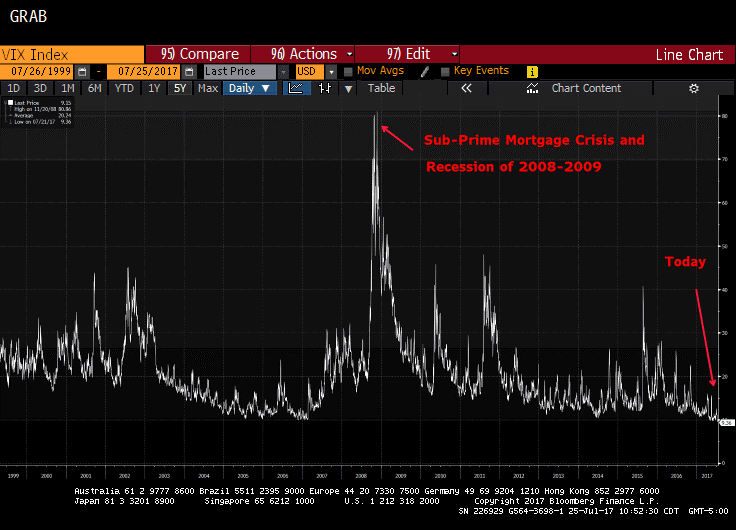The silence is almost deafening. Navigating the quiet markets is like being in a library. (Remember those places you used to go to find books before you could buy them online for $8.00?)
We’ve alluded to the Volatility Index (VIX) in past Investment Commentaries. The VIX, which is derived from a complicated formula, measures the implied volatilities of a wide range of S&P 500 index options. It’s not important that you understand the formula. Just know that when investors expect prices to change dramatically, option prices increase and the VIX rises. When they expect little change, option prices decrease and the VIX declines.
The graph below shows the VIX dating back to 1999, although the Chicago Board of Options Exchange (CBOE) started tracking it in 1993.
The VIX is trading at some of the lowest levels ever, including the years that are not shown in the graph. It hit an intraday historic low last week of 9.04.
To put that into perspective, it traded as high as 82 during the subprime mortgage crisis and recession of 2008-2009.

And it just seems to keep getting quieter every day. Complacency is in abundance. And when complacency is in abundance, markets tend to trend higher. When panic is in abundance, markets tend to trend lower.
If anyone cares, the Fed met last week and opted to leave interest rates as they are. It was no surprise to anyone, and we expect another hike at year’s end or early 2018. So what? This has absolutely no bearing on our investment strategy, nor does it change our view that long-term interest rates will remain low.
The next move in the Fed’s return to normalcy is reducing the size of its balance sheet. Before the financial crisis, the Fed held less than $1 trillion in securities, mostly U.S. Treasuries. After injecting hundreds of BILLIONS of dollars into the financial system, it now holds well over $4 trillion in securities (including $1.8 trillion in mortgage-backed securities of which it previously held none). To unwind these bonds, the Fed will let maturing bonds pay off and forego reinvesting the proceeds, effectively removing cash from the system. After years of low growth, the Fed is finally starting to feel comfortable removing itself from the picture.
Speaking of growth, it was just announced that the U.S. economy grew at an annualized rate of 2.6% in the second quarter. Although if you average it with the lackluster first quarter, the first six months come in at just under 2%.
____________________
July was another positive month for markets throughout the world. The S&P 500 advanced over 2% and foreign stocks increased over 3.5%.
A declining U.S. dollar aided stock valuations here and overseas. The dollar has steadily declined in value since its impressive rally after the Trump election. After peaking at 103.30 December 28th, the dollar has declined against most major currencies by about 10%.
A cheaper dollar helps the earnings of U.S. companies that sell products overseas (like Caterpillar or most pharmaceutical companies) because they convert their foreign income into more dollars because they are cheaper. A cheaper dollar also helps the economies of emerging markets, many of which have debt denominated in dollars.
Our allocation to emerging markets has been our best performing asset class this year, with investments in Turkey and Greece leading the way. No, we don’t own Venezuela yet, but as bad as the situation is there, we might start getting interested. We try to be contrarian investors (which is why we own Turkey and Greece) and you can’t get much more contrarian than Venezuela. However, we might wait just a wee bit longer.
____________________
We feel that investors who were so excited about what the possibilities of a Trump presidency could mean might start to get impatient soon. The initial stock market rally and bond market sell-off after the election were signs that investors were expecting pro-growth policies that would result in inflation.
Eight months later, people are realizing that just because the Republicans own the House and the Senate doesn’t mean that Trump owns the House and the Senate. Don’t forget… the Republican party basically disowned Donald Trump DURING the campaign. There are probably more than a couple who wouldn’t mind seeing him be less than successful.
Health care reform has fallen flat so our expectations for tax reform have been diminished. If he is not going to get a consensus on a tax reform package, markets might begin to act a little disappointed.
At Boyer & Corporon Wealth Management, we see nothing to cause us to hedge our investment strategies at this time. Volatility remains low to almost non-existent. The credit markets are calm, calm, calm, and interest rates remain low. President Trump’s ill-advised tweets notwithstanding, we remain confident (but vigilant) investors.
Speaking of tweets, you can follow us on Twitter @boyercorporon.
This information is provided for general information purposes only and should not be construed as investment, tax, or legal advice. Past performance of any market results is no assurance of future performance. The information contained herein has been obtained from sources deemed reliable but is not guaranteed.
This information is provided for general information purposes only and should not be construed as investment, tax, or legal advice. Past performance of any market results is no assurance of future performance. The information contained herein has been obtained from sources deemed reliable but is not guaranteed.
